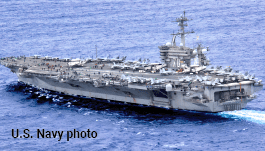By land or by sea, water professionals ensure public health
May 2, 2024

AWWA Articles
By land or by sea, water professionals ensure public health
This is an excerpt from a column recently published by the New York City Department of Environmental Protection. It was written by Paul Rush, deputy commissioner for the city’s Bureau of Water Supply, and the Water Research Foundation’s representative on the American Water Works Association’s board and the Water Utility Council. Rush is a graduate of the U.S. Military Academy at West Point and served as an officer in the U.S. Army for more than four years.
 In February I sailed from Hawaii to San Diego aboard the U.S.S. Carl Vinson, a nuclear-powered aircraft carrier. My son is one of 5,000 sailors who perform a variety of tasks to keep the ship and its 60 embarked aircraft running.
In February I sailed from Hawaii to San Diego aboard the U.S.S. Carl Vinson, a nuclear-powered aircraft carrier. My son is one of 5,000 sailors who perform a variety of tasks to keep the ship and its 60 embarked aircraft running.
During the seven days I lived aboard, I began to appreciate how the carrier functioned and the ways in which the crew lived and worked together. The slight chlorine residual I noticed when I drank my first cup of water from a tap on the ship really piqued my water supply curiosity.
I was surprised the water had a very pleasant taste without a hint of metallic flavor. This gave me confidence that attention was being paid to the ship’s water supply system. It also explained why nearly every sailor carried a personal water bottle filled from the ship’s water coolers.
 During a tour of the ship’s medical and dental departments, I spoke with Hospital Corpsman 3rd Class (HM3) Ty Cobler from Cut and Shoot, Texas. He explained the ship’s water supply production and testing protocols, which are:
During a tour of the ship’s medical and dental departments, I spoke with Hospital Corpsman 3rd Class (HM3) Ty Cobler from Cut and Shoot, Texas. He explained the ship’s water supply production and testing protocols, which are:
- Boil seawater and condense resulting steam into freshwater.
- After further cooling, treat water with sodium hypochlorite and distribute throughout the ship.
- Each day collect 12 samples at drinking water taps throughout the ship and test for chlorine residual.
- Conduct weekly bacteriological analysis on the ship to detect the presence or absence of coliform bacteria.
- If coliform is identified in any of the ship’s samples, a further step is taken using fluorescence to determine if E. coli is present.
I was fortunate to have had the opportunity to spend time on the U.S.S. Carl Vinson and was completely impressed with the entire team onboard, especially the staff involved in preventative medicine and water production.
I think it is equally important for the water sector to continue to find opportunities to share the outstanding work and dedicated service performed on a daily basis by water professionals who protect public health.
(Photo of U.S.S. Carl Vinson, credit U.S. Navy Petty Officer 3rd Class Isaiah Goessl)
Advertisement